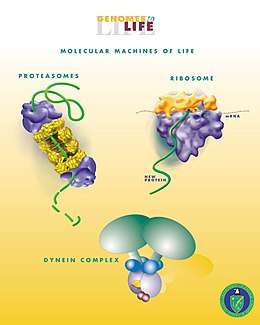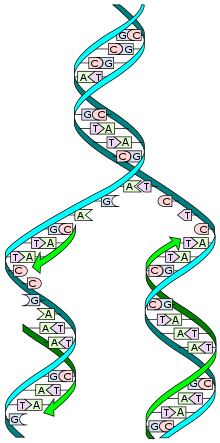Biological engineering
Biological engineering, or bioengineering/bio-engineering, is the application of principles of biology and the tools of engineering to create usable, tangible, economically viable products.[1] Biological engineering employs knowledge and expertise from a number of pure and applied sciences,[2] such as mass and heat transfer, kinetics, biocatalysts, biomechanics, bioinformatics, separation and purification processes, bioreactor design, surface science, fluid mechanics, thermodynamics, and polymer science. It is used in the design of medical devices, diagnostic equipment, biocompatible materials, renewable bioenergy, ecological engineering, agricultural engineering, and other areas that improve the living standards of societies. Examples of bioengineering research include bacteria engineered to produce chemicals, new medical imaging technology, portable and rapid disease diagnostic devices, prosthetics, biopharmaceuticals, and tissue-engineered organs.[3][4] Bioengineering overlaps substantially with biotechnology and the biomedical sciences[5] in a way analogous to how various other forms of engineering and technology relate to various other sciences (for example, aerospace engineering and other space technology to kinetics and astrophysics).


In general, biological engineers (or biomedical engineers) attempt to either mimic biological systems to create products or modify and control biological systems so that they can replace, augment, sustain, or predict chemical and mechanical processes.[6] Bioengineers can apply their expertise to other applications of engineering and biotechnology, including genetic modification of plants and microorganisms, bioprocess engineering, and biocatalysis. Working with doctors, clinicians and researchers, bioengineers use traditional engineering principles and techniques and apply them to real-world biological and medical problems.[7]
History
Biological engineering is a science-based discipline founded upon the biological sciences in the same way that chemical engineering, electrical engineering, and mechanical engineering[8] can be based upon chemistry, electricity and magnetism, and classical mechanics, respectively.[9] And it has the same fundamental attention to cost-effectiveness as all branches of engineering do.
Before WWII, biological engineering had just begun being recognized as a branch of engineering, and was a very new concept to people. Post-WWII, it started to grow more rapidly, partially due to the term "bioengineering" being coined by British scientist and broadcaster Heinz Wolff in 1954 at the National Institute for Medical Research. Wolff graduated that same year and became the director of the Division of Biological Engineering at the university. This was the first time Bioengineering was recognized as its own branch at a university. Electrical engineering is considered to pioneer this engineering sector due to its work with medical devices and machinery during this time.[10] When engineers and life scientists started working together, they recognized the problem that the engineers didn't know enough about the actual biology behind their work. To resolve this problem, engineers who wanted to get into biological engineering devoted more of their time and studies to the details and processes that go into fields such as biology, psychology, and medicine.[11] The term biological engineering may also be applied to environmental modifications such as surface soil protection, slope stabilization, watercourse and shoreline protection, windbreaks, vegetation barriers including noise barriers and visual screens, and the ecological enhancement of an area. Because other engineering disciplines also address living organisms, the term biological engineering can be applied more broadly to include agricultural engineering.
The first biological engineering program was created at University of California, San Diego in 1966, making it the first biological engineering curriculum in the United States.[12] More recent programs have been launched at MIT[13] and Utah State University.[14] Many old agricultural engineering departments in universities over the world have re-branded themselves as agricultural and biological engineering or agricultural and biosystems engineering, due to biological engineering as a whole being a rapidly developing field with fluid categorization. According to Professor Doug Lauffenburger of MIT,[13][15] biological engineering has a broad base which applies engineering principles to an enormous range of size and complexities of systems. These systems range from the molecular level (molecular biology, biochemistry, microbiology, pharmacology, protein chemistry, cytology, immunology, neurobiology and neuroscience) to cellular and tissue-based systems (including devices and sensors), to whole macroscopic organisms (plants, animals), and can even range up to entire ecosystems.
Education
The average length of study is three to five years, and the completed degree is signified as a bachelor of engineering (B.S. in engineering). Fundamental courses include thermodynamics, bio-mechanics, biology, genetic engineering, fluid and mechanical dynamics, kinetics, electronics, and materials properties.[16][17]
Sub-disciplines
Depending on the institution and particular definitional boundaries employed, some major branches of bioengineering may be categorized as (note these may overlap):
- Biomedical engineering: application of engineering principles and design concepts to medicine and biology for healthcare purposes.[18]
- Biochemical engineering: fermentation engineering, application of engineering principles to microscopic biological systems that are used to create new products by synthesis, including the production of protein from suitable raw materials.[18]
- Biological systems engineering: application of engineering principles and design concepts to agriculture, food sciences, and ecosystems.[8]
- Bioprocess engineering: develops technology to monitor the conditions of the where the process of making pharmaceuticals takes place,[18] (Ex: bioprocess design, biocatalysis, bioseparation, bioinformatics, bioenergy)
- Environmental health engineering: application of engineering principles to the control of the environment for the health, comfort, and safety of human beings. It includes the field of life-support systems for the exploration of outer space and the ocean.[18]
- Human-factors engineering: application of engineering, physiology, and psychology to the optimization of the human–machine relationship.[18]
- Biotechnology: the use of living systems and organisms to develop or make products.[19] (Ex: pharmaceuticals).[18]
- Biomimetics: the imitation of models, systems, and elements of nature for the purpose of solving complex human problems. (Ex: velcro, designed after George de Mestral noticed how easily burs stuck to a dog's hair).[20]
- Bioelectrical engineering
- Biomechanical engineering
- Bionics: an integration of Biomedical, focused more on the robotics and assisted technologies. (Ex: prosthetics)[18]
- Bioprinting: utilizing biomaterials to print organs and new tissues[21]
- Biorobotics: (Ex: prosthetics)
- Systems biology: The study of biological systems.
Organizations
- Accreditation Board for Engineering and Technology (ABET),[22] the U.S.-based accreditation board for engineering B.S. programs, makes a distinction between biomedical engineering and biological engineering, though there is much overlap (see above).
- American Institute for Medical and Biological Engineering (AIMBE) is made up of 1,500 members. Their main goal is to educate the public about the value biological engineering has in our world, as well as invest in research and other programs to advance the field. They give out awards to those dedicated to innovation in the field, and awards of achievement in the field. (They do not have a direct contribution to biological engineering, they more recognize those who do and encourage the public to continue that forward movement).[23]
- Institute of Biological Engineering (IBE) is a non-profit organization, they run on donations alone. They aim to encourage the public to learn and to continue advancements in biological engineering. (Like AIMBE, they do not perform research directly; however, they offer scholarships to students who show promise in the field).[24]
- Society for Biological Engineering (SBE) is a technological community associated with the American Institute of Chemical Engineers (AIChE). SBE hosts international conferences, and is a global organization of leading engineers and scientists dedicated to advancing the integration of biology with engineering.[25]
References
- Abramovitz, Melissa (2015). Biological engineering. Gale Virtual Reference Library. p. 10. ISBN 978-1-62968-526-7.
- Herold, Keith; Bentley, William E.; Vossoughi, Jafar (2010). The Basics of Bioengineering Education. 26Th Southern Biomedical Engineering Conference, College Park, Maryland. p. 65. ISBN 9783642149979.CS1 maint: location (link)
- "What is Bioengineering?". bioeng.berkeley.edu. Retrieved 2018-07-21.
- "MSB: About the Munich School of BioEngineering". www.bioengineering.tum.de. Retrieved 2020-02-03.
- "Biotechnology vs Biomedical Science vs Biomedical Engineering (Bioengineering)". Tanmoy Ray. 2018-07-19. Retrieved 2018-07-21.
- Pasotti, Lorenzo; Zucca, Susanna (2014-08-03). "Advances and Computational Tools towards Predictable Design in Biological Engineering". Computational and Mathematical Methods in Medicine. 2014: 369681. doi:10.1155/2014/369681. PMC 4137594. PMID 25161694.
- Sheffield, University of. "What is bioengineering? - Bioengineering - The University of Sheffield". www.sheffield.ac.uk. Retrieved 2018-07-21.
- Abramovitz, Melissa (2015). Biological Engineering. Gale Virtual Reference Library. p. 18. ISBN 978-1-62968-526-7.
- Cuello JC, Engineering to biology and biology to engineering, The bi-directional connection between engineering and biology in biological engineering design, Int J Engng Ed 2005, 21, 1-7
- Medical & biological engineering. Oxford ; New York: Pergamon Press. 1966–1976.CS1 maint: date format (link)
- Naik, edited by Ganesh R. (2012). Applied biological engineering : principles and practice. Rijeka: InTech. ISBN 9789535104124.CS1 maint: extra text: authors list (link)
- "Founder of UCSD Bioengineering Program". jacobsschool.ucsd.edu. 1 Mar 2004. Retrieved 22 May 2018.
- "MIT, Department of Biological Engineering". Retrieved 16 April 2015.
- "Utah State University, Department of Biological Engineering". be.usu.edu. Retrieved 2011-11-13.
- "MIT Directory, Doug Lauffenburger". Retrieved 15 April 2015.
- Linsenmeier RA, Defining the Undergraduate Biomedical Engineering Curriculum
- Johnson AT, Phillips WM. "Philosophical foundations of biological engineering". Journal of Engineering Education. 1995 (84): 311–318.
- "Bioengineering". Encyclopedia Britannica.
- "Convention on Biological Diversity". Retrieved 27 April 2018.
- "Biomimetics: its practice and theory". Royal Society Publishing.
- "Bioprinting". Retrieved 1 May 2018.
- ABET Accreditation, accessed 9/8/2010.
- "AIMBE About Page".
- "Institute of Biological Engineering". Retrieved 20 April 2018.
- "The Society for Biological Engineering". Retrieved 21 August 2019.
External links
- Bioengineering Society
- Biomedical Engineering Society
- Institute of Biological Engineering
- Benjoe Institute of Systems Biological Engineering
- American Institute of Medical and Biological Engineering
- American Society of Agricultural and Biological Engineers
- Society for Biological Engineering part of AIChE
- Journal of Biological Engineering, JBE
- Biological Engineering Transactions
- Munich School of BioEngineering

